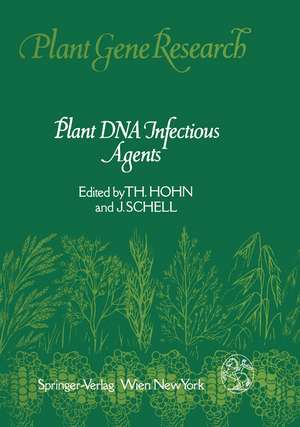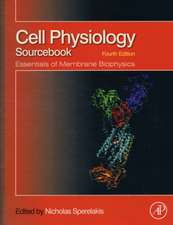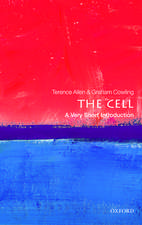Plant DNA Infectious Agents: Plant Gene Research
Editat de Thomas Hohn, Josef Schellen Limba Engleză Paperback – oct 2011
Preț: 648.24 lei
Preț vechi: 762.64 lei
-15% Nou
Puncte Express: 972
Preț estimativ în valută:
124.04€ • 129.84$ • 103.24£
124.04€ • 129.84$ • 103.24£
Carte tipărită la comandă
Livrare economică 31 martie-14 aprilie
Preluare comenzi: 021 569.72.76
Specificații
ISBN-13: 9783709174586
ISBN-10: 3709174589
Pagini: 368
Ilustrații: XIV, 348 p.
Dimensiuni: 178 x 254 x 19 mm
Greutate: 0.64 kg
Ediția:Softcover reprint of the original 1st ed. 1987
Editura: SPRINGER VIENNA
Colecția Springer
Seria Plant Gene Research
Locul publicării:Vienna, Austria
ISBN-10: 3709174589
Pagini: 368
Ilustrații: XIV, 348 p.
Dimensiuni: 178 x 254 x 19 mm
Greutate: 0.64 kg
Ediția:Softcover reprint of the original 1st ed. 1987
Editura: SPRINGER VIENNA
Colecția Springer
Seria Plant Gene Research
Locul publicării:Vienna, Austria
Public țintă
ResearchCuprins
1 The Molecular Biology of Cauliflower Mosaic Virus and Its Application as Plant Gene Vector.- I. Introduction.- II. The Biology of Cauliflower Mosaic Virus.- III. The Development of CaMV into a Plant Gene Vector.- IV. Elements of CaMV as Tools in Plant Genetic Engineering.- V. Vector Based on Other Plant Viruses.- VI. Conclusion and Outlook.- VII. References.- 2 The Structure, Expression, Functions and Possible Exploitation of Geminivirus Genomes.- I. Introduction.- II. Genome Organisation.- III. Gene Expression.- IV. Gene Functions.- V. The Potential of Geminiviruses as Gene Vectors.- VI. References.- 3 cDNA Cloning of Plant RNA Viruses and Viroids.- I. General Introduction.- II. Construction of Full-Length cDNA Clones.- III. DNA Copies as Tools to Study the Molecular Biology of Plant RNA Viruses.- IV. Viroids and Satellites.- V. Diagnosis of Plant Diseases Using DNA Copies of Plant Viruses and Viroids.- VI. Conclusions and Future Aspects.- VII. References.- 4 Agroinfection.- I. Introduction.- II. Potential Applications of Agroinfection.- III. Perspectives.- IV. References.- 5 The Mechanism of T-DNA Transfer from Agrobacterium tumefaciens to the Plant Cell.- I. General Introduction.- II. Early Events of Transformation.- III. T-DNA Processing.- IV. Conclusions.- V. References.- 6 Molecular Analysis of Root Induction by Agrobacterium rhizogenes.- I. Introduction.- II. Taxonomy.- III. Ri Plasmid Structure.- IV. Ri T-DNA Organization.- V. T-DNA of Ri Transformed Plants.- VI. Endogenous T-DNA of Plants.- VII. Conclusions and Further Speculations.- VIII. References.- 7 Pathways to Plant Genetic Manipulation Employing Agrobacterium.- I. Introduction.- II. Biology of Agrobacterium tumefaciens Ti Plasmid.- III. Strategies for Inserting Genes into T-DNA.- IV. Practical Catalogue.- V. Getting Genes into Plants.- VI. Novel Applications of Ti Transformation.- VII. Prospects.- VIII. References.- 8 Plant Transposable Elements: Unique Structures for Gene Tagging and Gene Cloning.- I. Introduction.- II. Isolation and Characterization of a Transposable Element.- III. Transposable Elements as Molecular Probes for Gene Isolation.- IV. Conclusions.- V. References.- 9 Direct Gene Transfer to Plants.- I. Direct Gene Transfer.- II. Other Vectorless Gene Transfer Systems.- III. Direct Gene Transfer in Theoretical and Applied Genetics.- IV. References.- 10 Microinjection: An Experimental Tool for Studying and Modifying Plant Cells.- I. Introduction.- II. Recipient Cell Systems.- III. Resolution of Intracellular Compartments.- IV. Microinjection Methodology.- V. Genetic Transformation.- VI. Other Applications.- VII. Concluding Remarks.- VIII. References.- 11 Transformation of Chlamydomonas Reinhardtii.- I. Introduction.- II. Nuclear Transformation.- III. Prospects of Chloroplast Transformation in C. reinhardtii.- IV. Conclusions.- V. References.- 12 Induction of Expression in and Stable Transformation of an Algal Cell by Nuclear Microinjection with Naked DNA.- I. Introduction.- II. Acetabularia.- III. Techniques.- IV. Expression of Genomic RNA.- V. Expression of Genomic DNA.- VI. Expression of Genes and Gene Constructions.- VII. Regulation of Expression.- VIII. Transformation.- IX. Genetics.- X. Discussion.- XI. References.- 13 Transient Expression of DNA in Plant Cells.- I. Overview of Transient Assay Applications.- II. Transient Assays in Plant Cells.- III. Transient Expression after Electroporation-Mediated Gene Transfer.- IV. Discussion.- V. References.- 14 Plastid Transformation: A Progress Report.- I. Introduction.- II. Construction of Vectors for the Transformation of Plastids.- III. General Conclusions.- IV. References.- 15 Targeting Nuclear Gene Products into Chloroplasts.- I. Introduction.- II. Binding of Precursors to the Outer Membrane of the Chloroplast.- III. Translocation of Polypeptides Across the Envelope Membranes.- IV. Processing of Precursors to the Nature Polypeptide.- V. The Transit Peptide Itself can Mediate Import of Foreign Polpeptides.- VI. Structural Analysis of Chloroplast Transit Peptides.- VII. Experimental Analysis of Transit Peptides.- VIII. Future Prospects.- IX. References.

















